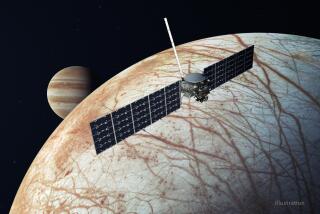Launch of Pluto Mission Delayed Because of Wind
- Share via
High winds at Cape Canaveral in Florida forced NASA to scrub the launch of the New Horizons spacecraft to Pluto, the last unexplored planet in the solar system.
The countdown was called off at 12:20 p.m. Pacific time, when winds at the launchpad exceeded 38 mph, the limit permitted by NASA regulations.
The space agency rescheduled the launch of the $700-million mission to 10:16 a.m. today.
A two-hour launch window is available each day through the end of January, at which time NASA could be forced to change the spacecraft’s trajectory, adding three years to the journey.
NASA officials said all spacecraft systems were functioning properly when the launch was scrubbed.
New Horizons will be the fastest spacecraft ever launched by NASA, traveling at 36,000 mph when it leaves Earth’s orbit. It will reach its top speed of 47,000 mph in 2007, after using Jupiter’s gravity to slingshot itself into the outer solar system.
If all goes as planned, the spacecraft will reach Pluto, the ninth plant in the solar system, in July 2015, after a nine-year journey. Passing within 6,200 miles of the planet’s surface, New Horizons will measure the small ice world’s atmosphere and map its surface. Its instruments will be able to home in on features as small as a football field.
New Horizons scientists say Pluto is important to understanding how the solar system formed.
The planet is part of what is known as the Kuiper Belt, a collection of debris and planetoids beyond Neptune. Pluto was once thought to be a frigid anomaly on the far edge of the solar system. Scientists now say small bodies of ice and rock -- at least one of which is larger than Pluto -- are being discovered constantly in the Kuiper Belt, and that they are by far the most common objects in the solar system.
NASA is being cautious about New Horizons’ launch partly because the craft gets its electrical power from a small nuclear device called an RTG. Although there have been scattered protests over the use of plutonium on the spacecraft, NASA said RTGs have been used on more than two dozen missions without incident.
Some spacecraft generate electricity with solar panels, but New Horizons’ destination is so far from the sun that its rays would be too weak to produce power.
More to Read
Sign up for Essential California
The most important California stories and recommendations in your inbox every morning.
You may occasionally receive promotional content from the Los Angeles Times.










